After a long break, the Austrian Bundesliga finally returned. The German Bundesliga was the first European League to restart and last week also Austrian football celebrated its comeback with the final of the ÖFB Cup between RB Salzburg and Austria Lustenau which the team of Jesse Marsch easily won with 5-0 and therefore they were able to get the first trophy of this season.
Now, Salzburg logically wanted a good start in the Austrian Bundesliga to get themselves in a good position to also win the league. In Austria, the 12 teams get divided into two groups after the opening 22 games and then they fight for the championship and against the relegation respectively. Also, the points of all teams get halved. Due to that, after the opening 22 matchdays LASK wasn’t anymore six points ahead of RB Salzburg, but only three. Also, due to their infringement (as they made a normal training match even though this wasn’t allowed) they lost six points and due to that ahead of the restart RB Salzburg had 24 points (first position), LASK Linz collected 21 points (second position), Rapid Vienna collected 20 points (third position) and Wolfsberger AC had 19 points (fourth position).
Considering this, the match between RB Salzburg and Rapid Vienna was for both teams extremely important. In this tactical analysis, we will look at the tactics of both teams, how they changed throughout the game and discuss the reasons for the 2-0 victory of RB Salzburg.
Line-ups
Both teams switched their systems throughout the first half. While Rapid stuck to about the same formation, they had to make several changes due to injuries, RB Salzburg changed formation in the 36th minute which influenced both teams’ tactics.
Marsch lined his team up in a 4-4-2 formation with Cican Stankovic in goal and the back four consisted out of Andreas Ulmer, Maximilian Wöber, André Ramalho and Albert Vallci. Majeed Ashimeru and Enock Mwepu were the central midfielders and the wings got occupied by Zlatko Junuzović and Dominik Szoboszlai. Upfront Hee-chan Hwang and Patson Daka were the two strikers. The only change compared to the ÖFB Cup final was that Noah Okafor was on the bench and Mwepu started instead of him. Also, in the final Junuzović was in the centre and Okafor played on the wing.
On the other side, Dietmar Kühbauer used a mixture of a 3-4-3 (5-2-3) and a 3-5-2 (5-3-2) formation with Richard Strebinger between the sticks. Maximilian Hofmann, Filip Stojković and Christopher Dibon were the three centre-backs while Kelvin Arase and Maximilian Ullmann completed the back five. Dejan Ljubicic, Dejan Petrovič and Stefan Schwab were the midfielders while Christoph Knasmüllner joined the Greek striker Taxiarchis Fountas in the highest line. Schwab was the one who either played in the highest line or dropped a bit deeper and due to that, they switched between 3-4-3 and 3-5-2. However, Dibon got subbed off after about two minutes due to an injury and Mario Sonnleitner replaced him. Only 25 minutes later Sonnleitner also left the field due to an injury and due to that Ljubicic became the central man of the back five and Srdjan Grahovac who came on for Sonnleitner played instead of Ljubicic in the central midfield. Also, they needed to finish the game with 10 men since Thomas Murg who came on in the 72nd together with two other players (Rapid Vienna used all of their five possible substitutions) had also to go off the pitch due to an injury.
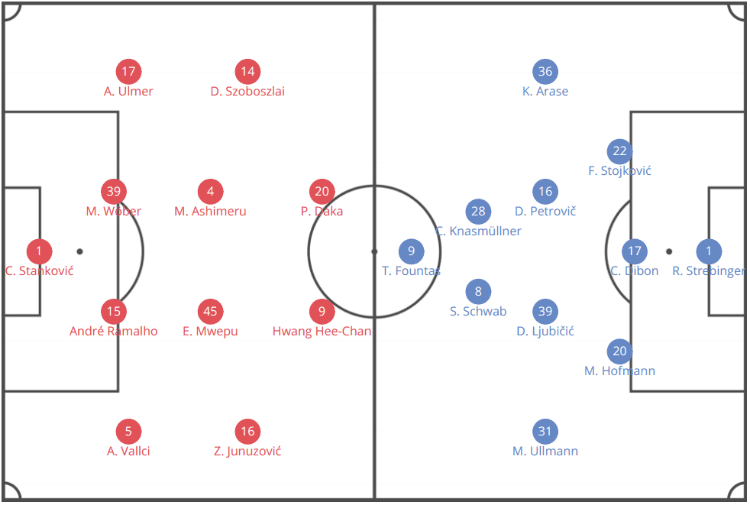
Salzburg’s build-up before the switch of system
Basically, we saw in the opening phase of the game what we could have expected as Salzburg dominated the match, tried to control the game and used their high press to give Rapid nearly no chance to have longer periods of possession. Additionally, the early injury of Dibon also didn’t help Rapid, but overall, they performed well and also didn’t just sit back deeper. Kühbauer’s side either put pressure on RB Salzburg higher up the pitch as we will see later in this section of the tactical analysis, or sat back a bit deeper and pressed at about the half-way line or a few yards deeper.
On the other side, Salzburg’s full-backs didn’t push as high as they normally do and stayed during the first phase a bit deeper. Ramalho and Wöber were responsible for the circulation of the ball during the first stage of the build-up and got supported by Mwepu and Ashimeru. The two central midfielders either stayed both in the centre in front of the centre-backs or occasionally Mwepu came deeper to create a back three. Szoboszlai and Junuzović were positioned in the half-spaces while Daka and Hwang stayed narrow. All these aspects can be seen in the graphic below.
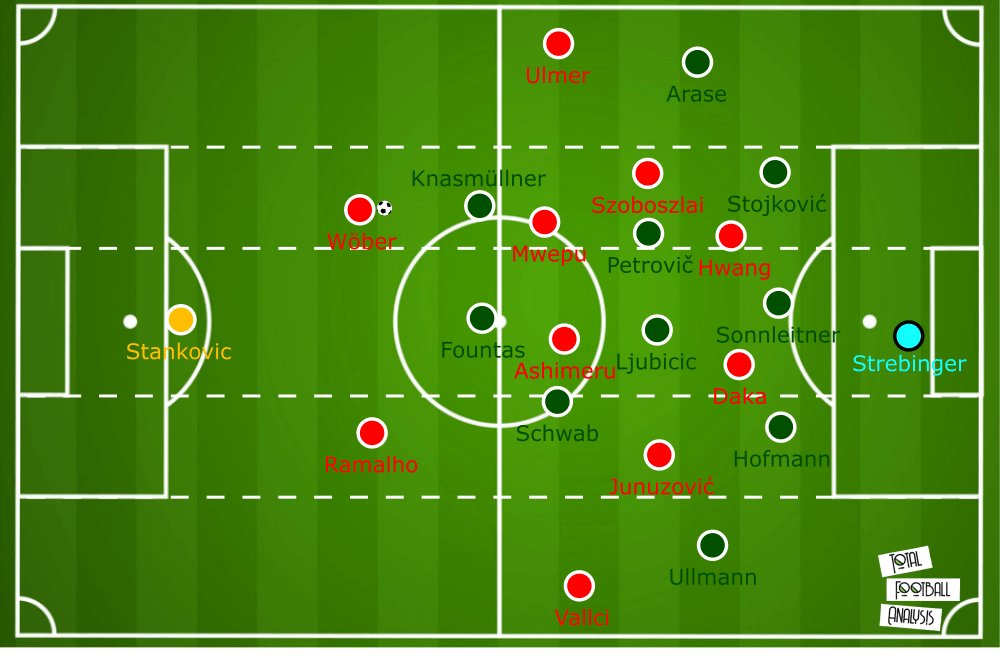
Also, note in the image above and the in-game example below the positioning of Schwab who either joined Fountas and Knasmüllner in the highest line or positioned deeper to have more bodies in the midfield. Sometimes, he was also somewhere in between these two lines as in the situation below.
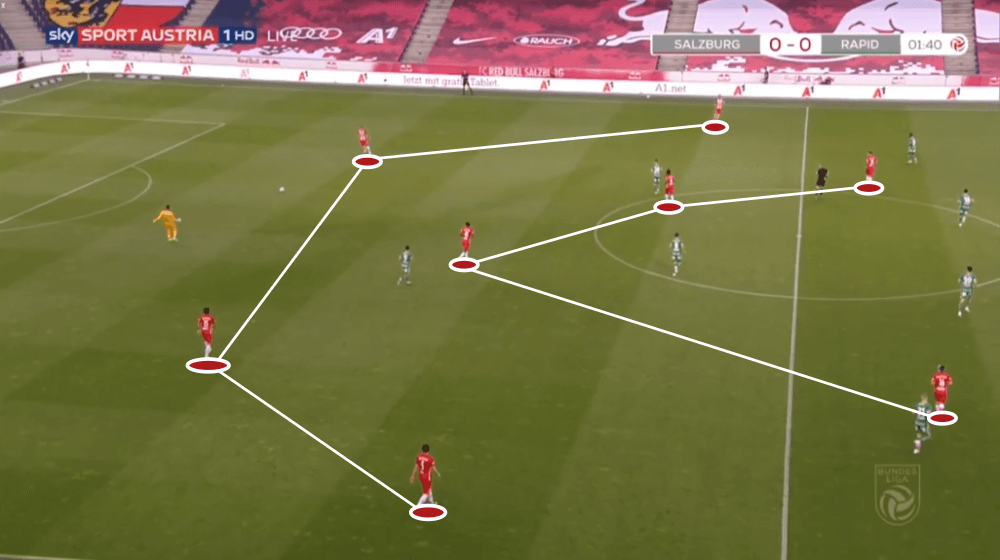
The side of Kühbauer followed one strict pattern when it comes to their press higher up the pitch as they wanted to eliminate Wöber, Ashimeru, Mwepu and Ulmer since these were the best ball-playing men in Salzburg’s starting eleven (if we only focus on the back four and the central midfielders). So, the two targets to press were Ramalho (right centre-back) and Vallci (right-back).
In the game the pattern was quite simple as they waited until Ramalho positioned wider what was especially the case when Mwepu dropped deeper as in the example below) and then as soon as the Brazilian received the ball, Schwab sprinted towards him (used his cover shadow to block the ball into the centre to Ashimeru), Fountas cut off the ball back to Wöber and Ullmann (left wing-back) was already near Vallci for the case the right-back received the ball. In the image below we can see these movements except the one of Ullmann since he and Vallci are out of the frame.
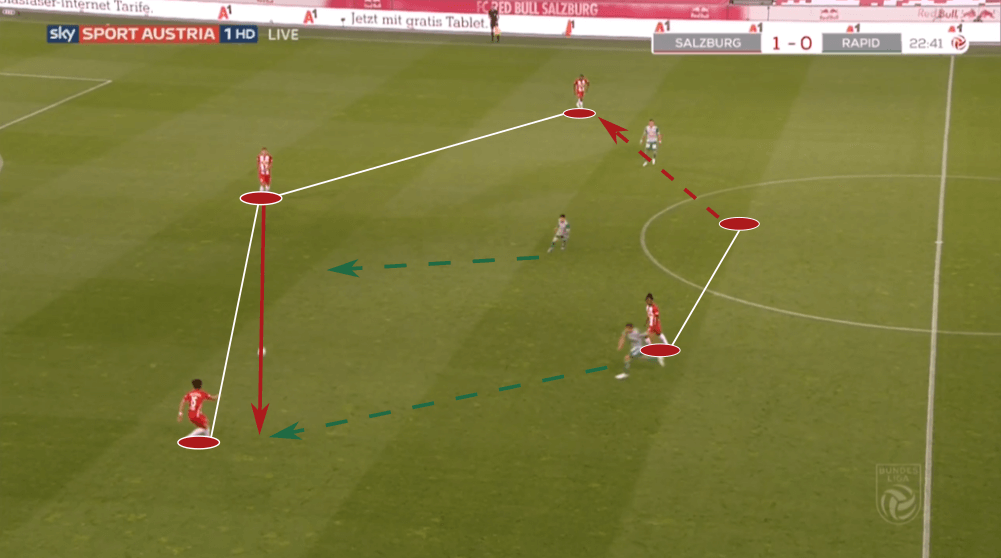
In this game, we saw once more a strong performance of Ashimeru who is getting better and better. He was already one important part of the victory in the cup final last week and was in this match once more besides Mwepu incredibly important for the progression of the ball. The Hütteldorfer tried in several situations to put pressure on him, but the central midfielder from Ghana stayed always calm and found the right solution as we can see in the example below.
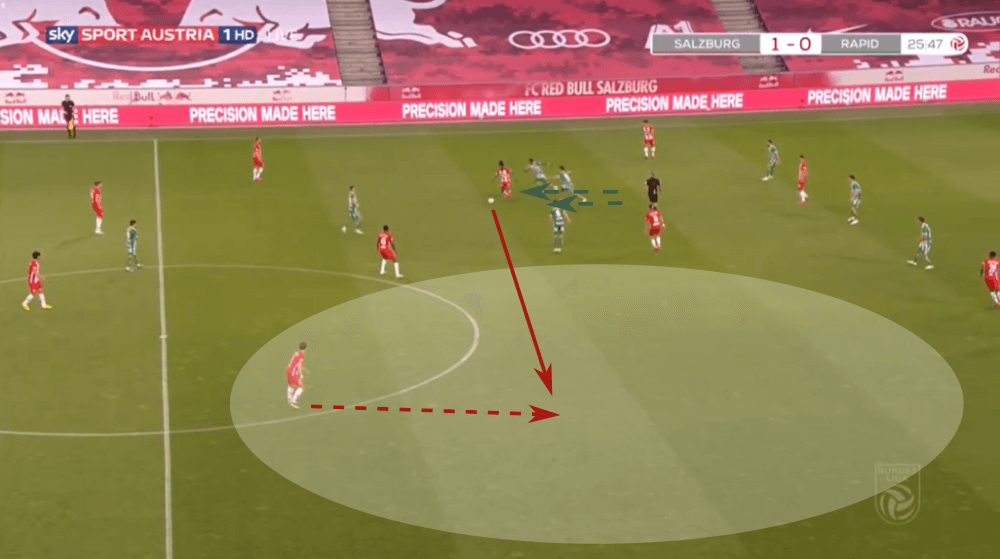
The importance of the half-spaces and counter-movements
When you watch RB Salzburg regularly you quickly notice that they almost never play with real wingers. When they use a 4-4-2 as they did in the first 36 minutes of the game, the wingers tuck in and the full-backs should provide width. If they play in a 3-5-2 formation as they did after the switch in the 36th minute, the wing-backs are the only two men who occupy the wing.
We already saw prior in this tactical analysis when we looked at the build-up structure of Marsch’s team that the two wingers Szoboszlai and Junuzović were mainly positioned in the half-spaces. This area is for RB Salzburg extremely important as they either try to find players with line-breaking passes in this areas and then they should have interplays with teammates in the space between the opposing defence and midfield or they play through passes in this area. In the shots below, we have two examples for those through passes and both of them are played through the right half-space.
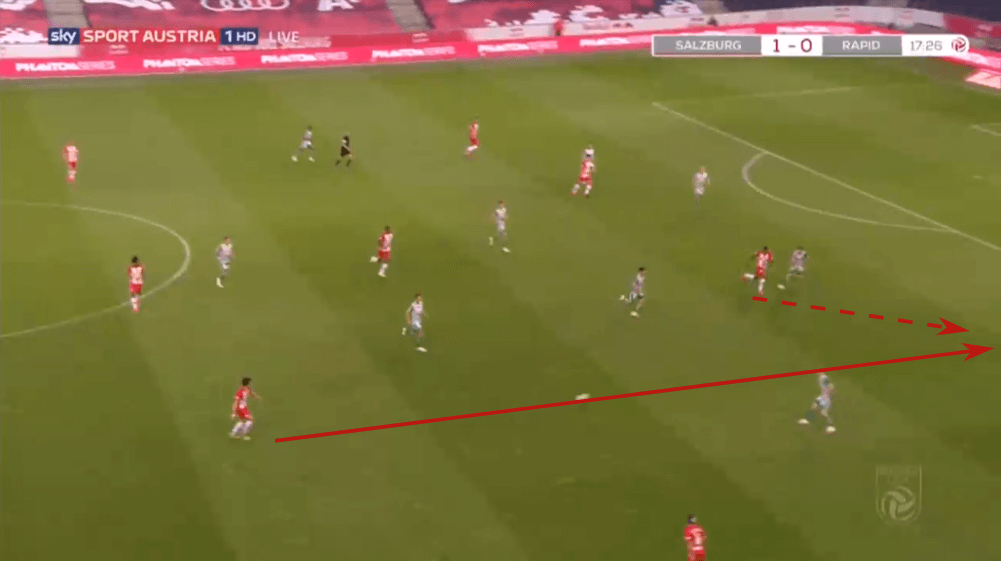
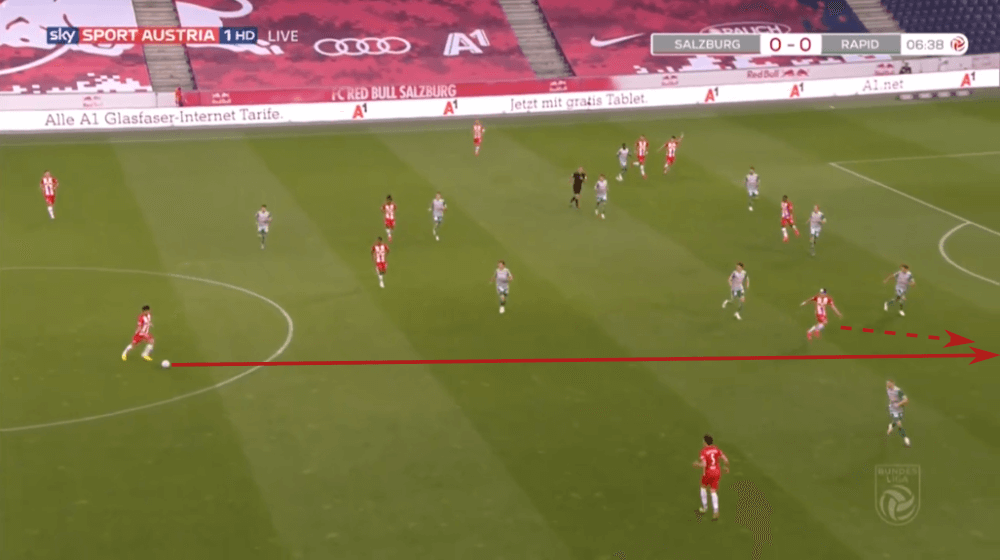
Another part of RB Salzburg’s tactics which was in this game really central were the counter-movements of the four players in the highest line (two strikers and two inverted wingers). We could permanently see that one of them dropped deeper, lured out one of the opposing defenders and then a teammate started exactly in that free space.
Since Junuzović is not incredibly fast and mainly positioned a bit deeper, these movements were mainly used by Szoboszlai (who is linked with clubs from the EPL and Serie A), Hwang and Daka who created space for each other. In the shot below we have an example for these movements which mainly worked out because the three centre-backs of Rapid Vienna were extremely man-orientated.
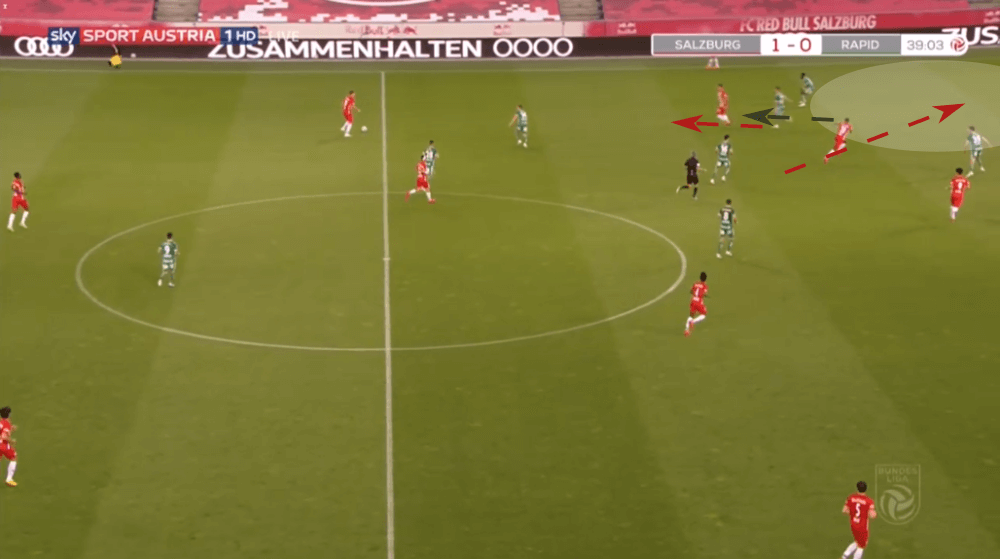
In general, long through passes behind the back five and back three respectively were very often used by Salzburg in this game. Also, both goals (9th minute and 90th minute) resulted out of long balls behind the defence of Rapid Vienna. Ahead of the first one, Ulmer found Daka with a long ball who scored with a header over the goalkeeper Strebinger who didn’t time his exit well (first image below). In the situation ahead of the deciding goal, Wöber found the incredibly fast Karim Adeyemi with a through pass (notice how the two right defenders of Rapid are lured out by Salzburg’s players). Adeyemi then delivered a low cross towards Okafor who then scored the 2-0 (second image).
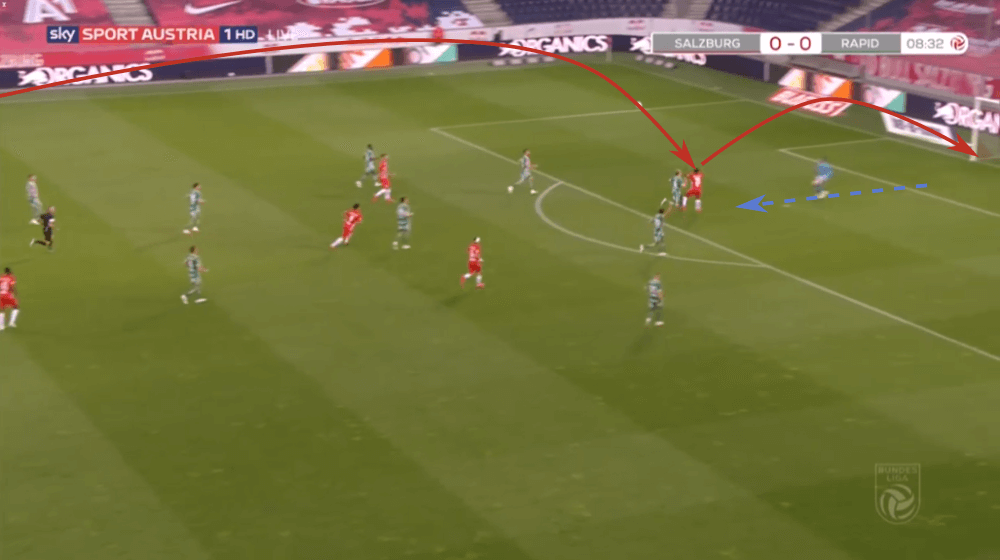
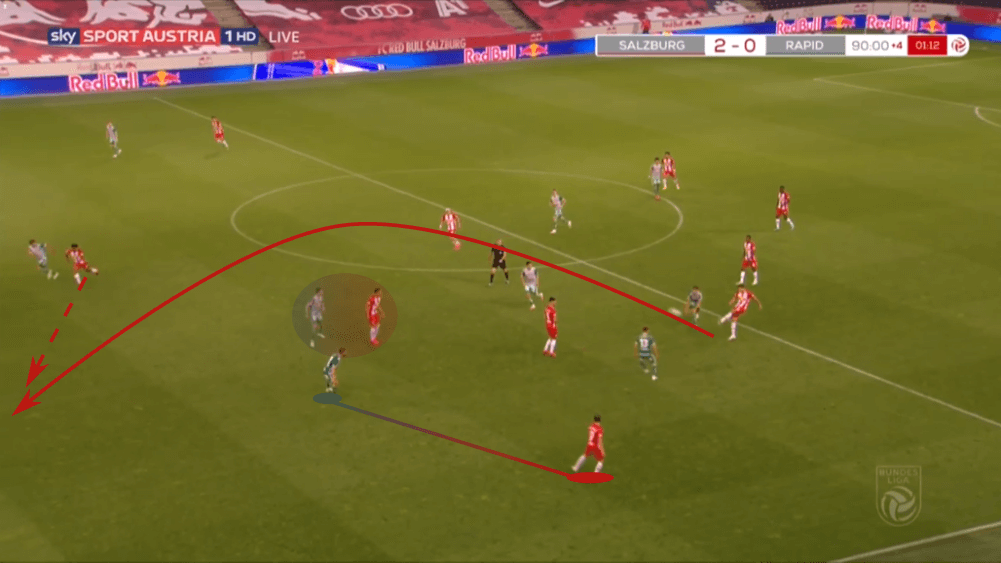
Rapid Vienna’s ideas in possession
In this section of this tactical analysis, we will focus on the tactics of Rapid Vienna in possession. Also, it is important to understand the plan for the progression of the ball since Marsch’s adjustment in the 36th minute was a reaction to this.
Salzburg often used a higher press, but also sometimes defended deeper in their 4-4-2 formation. Whenever Marsch’s side decided to put pressure on the opponents higher up the field, Rapid at first tried to solve it with short passes, but as soon as they noticed that this wouldn’t work, they used the same patterns as they did during the counter-attacks: long balls towards Fountas and Schwab, but we will look at this in more detail in the next section.
Kühbauer’s team built up their attacks in a 3-2-5 formation as the two wing-backs were positioned almost on the same height as the three forwards Schwab, Fountas and Knasmüllner. In the centre, either one midfielder stayed deep to support the three defenders who split up or both central men occupied the middle of the pitch. In the image below we can see about the structure of both teams when Salzburg pressed at about the half-way line or 10 yards higher.

One aspect which instantly stands out is that the midfield of Salzburg is narrow and besides Rapid have a 4vs2 numerical disadvantage in the midfield. But, at the same time, they have one more player more than Salzburg in the highest line. Therefore, it was always the goal to play the ball as soon as possible to Arase or Ullmann who permanently stayed near the touchline. Rapid Vienna knew that it would be hard to get through the centre since Salzburg defend extremely compact and due to that, they saw their best chances in the wide-areas.
In the example below this worked out well as Arase positioned wide, Ulmer had to stay central what created distance between these two. This distance gave Arase the time to scan the penalty area and then he delivered a perfect cross which led to the most dangerous chance of Rapid in the whole game.
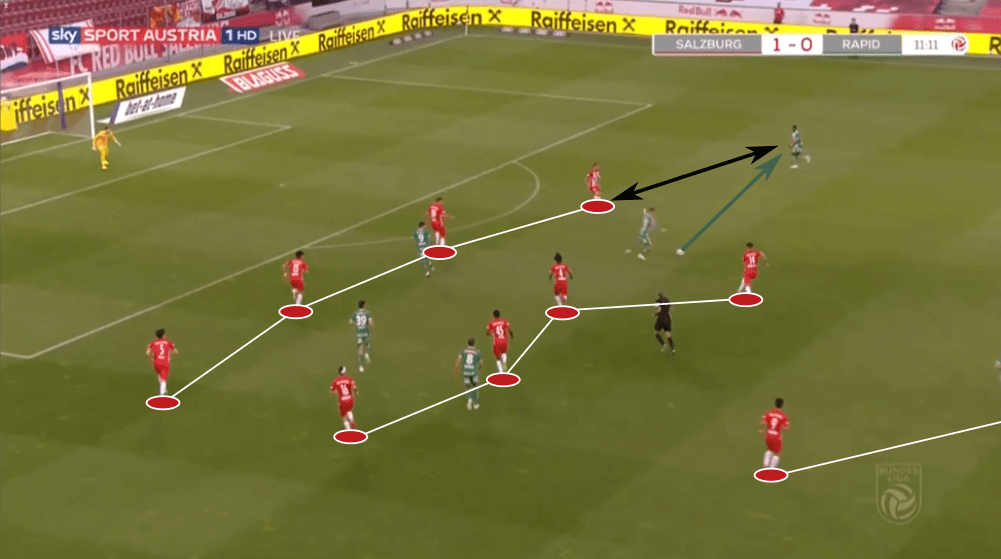
Considering these aspects, Rapid wanted to find one of their wing-backs as soon as possible since they had the most space and time due to RB Salzburg’s compact formation. Logically, Salzburg shifted extremely quickly towards those men as soon as they received the ball.
Due to that, Rapid Vienna often played to one side to force Salzburg shifting to that wing, just to then switch the side with one or two passes since then again, the wing-back had a lot of time and space. An example can be seen in the shot below.
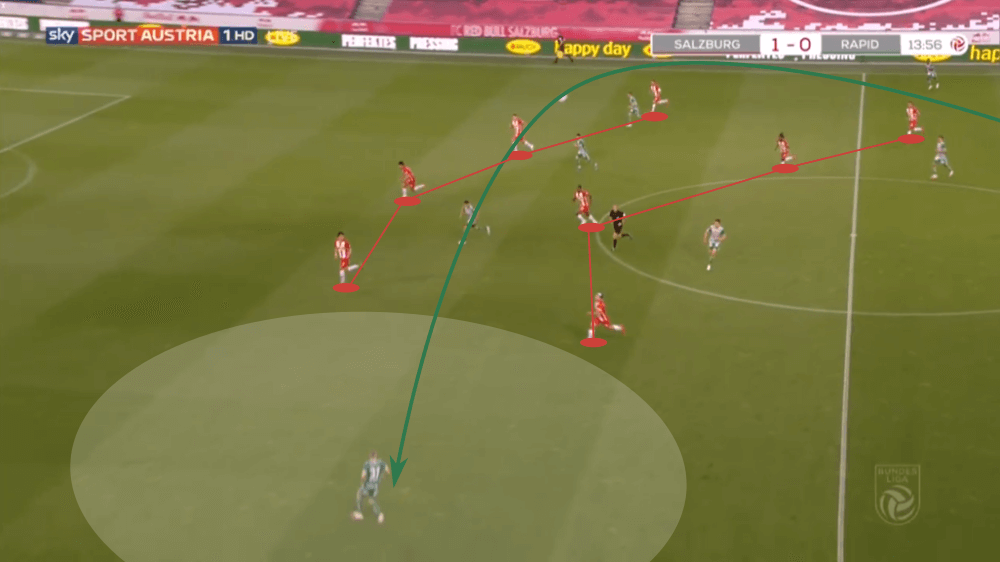
Since it is a central part of Salzburg’s tactics under Marsch to stay horizontally compact and force the opposition to play wide to then press there, Kühbauer’s side had clear patterns what to do as soon as the ball was played to the wing towards Ullmann or Arase.
Since Arase is clearly faster than Ulmer, the main goal on this side was to put him in an isolated one-on-one situation with the Austrian full-back. To do so, Knasmüllner often dropped deep as soon as the ball was played to the wide-area. Wöber followed him which gave Arase the chance to use his pace and dribble in the space behind Ulmer as we can see below.
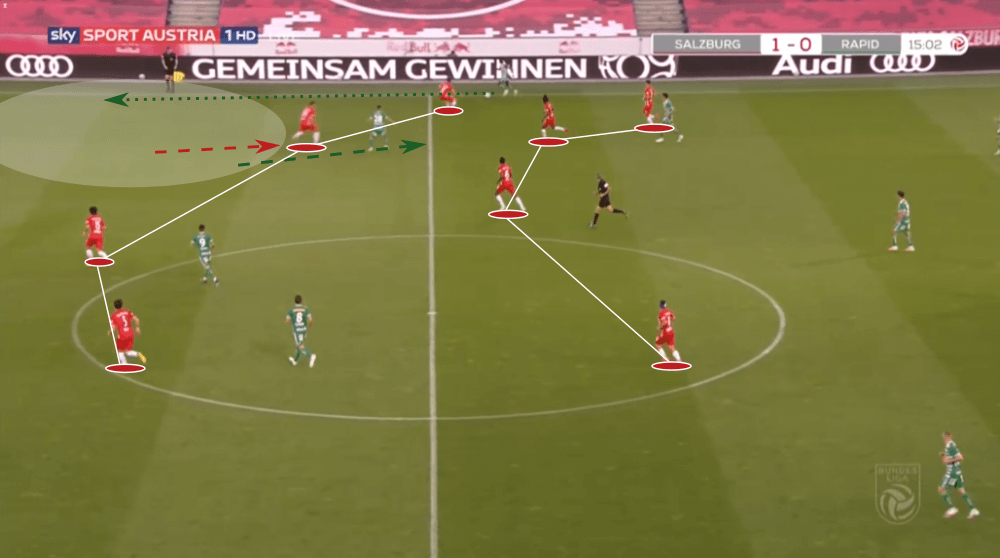
The second pattern which got used on both sides was to immediately play a vertical or diagonal ball behind the last line of Salzburg and exploit the space behind the full-back. So, on the right side, they either wanted to use Arase’s pace and abilities on the ball and get in that space with his dribbles or he should immediately play a through ball with his first contacct towards Knasmüllner (first image below). On the other side, Ullmann mainly played a through ball with his first touch towards Schwab (second image below). These patterns worked mainly off on the right side. Also, in the two shots below, in the first example it worked perfectly while in the second one Vallci intercepted the pass by Ullmann.
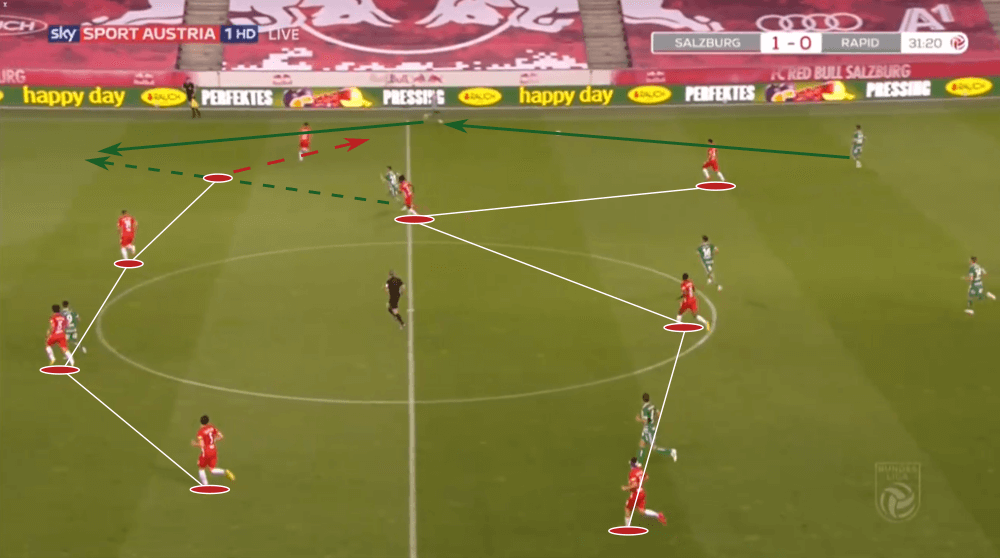
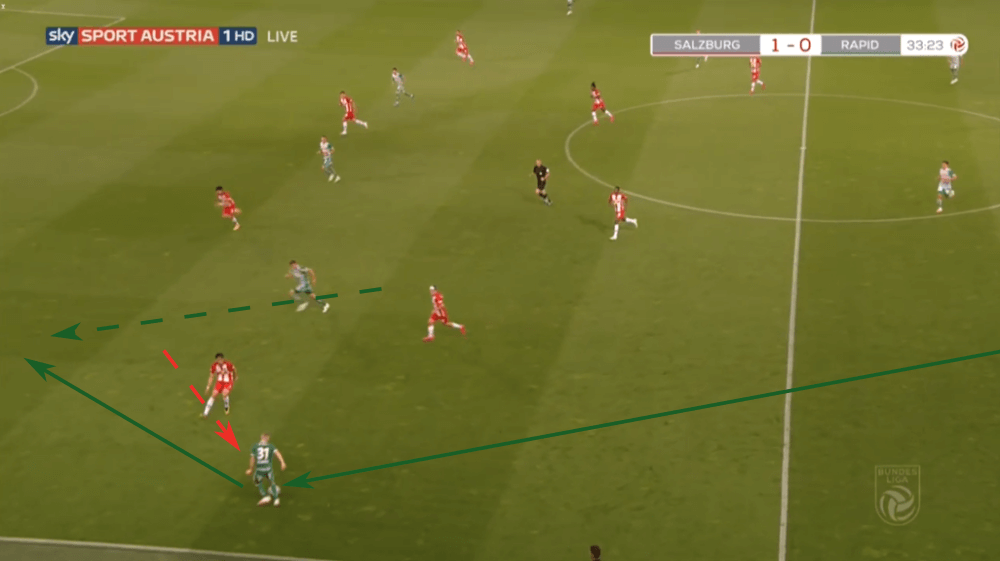
Fountas and Schwab as the central men during the offensive transition
Next, we will talk about the patterns of Rapid Vienna during the transition. Also, these passes and movements were often used when Salzburg decided to press in at them higher up the pitch. In such moments, they often looked to play the ball to the right-wing to Arase to free themselves of Salzburg’s press, but if this option wasn’t available, they went for the long balls towards Fountas and Schwab.
While Fountas was the target for low-thriven passes which he then mainly laid off for Knasmüllner, Schwab was the man for the long balls. The main principle was to get as soon as possible forward without giving the opposition the chance to execute their typical (counter-)pressing. In the first image below we can see how Fountas receives a vertical pass while in the second example Schwab lays off a long ball.
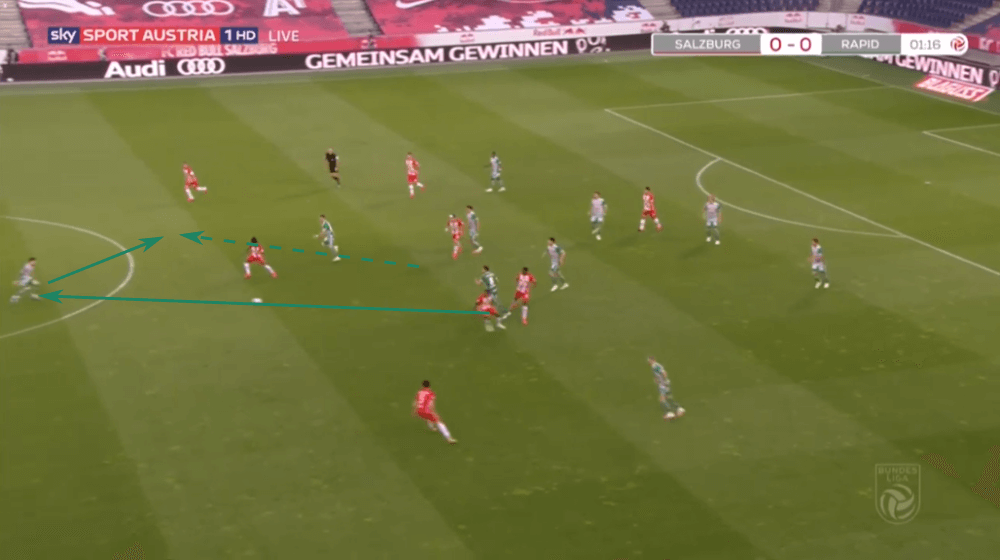
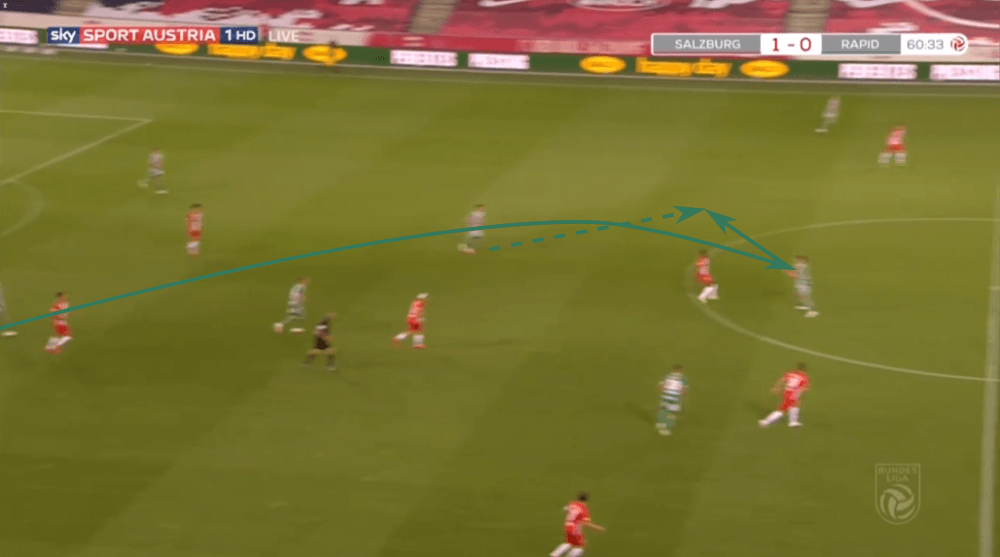
Also, in the second pattern we sometimes saw through passes to the wide-areas behind the full-backs of Salzburg. It was mainly Fountas who started runs into these areas as he was the player who was positioned high up the pitch. We can see an example for that below.
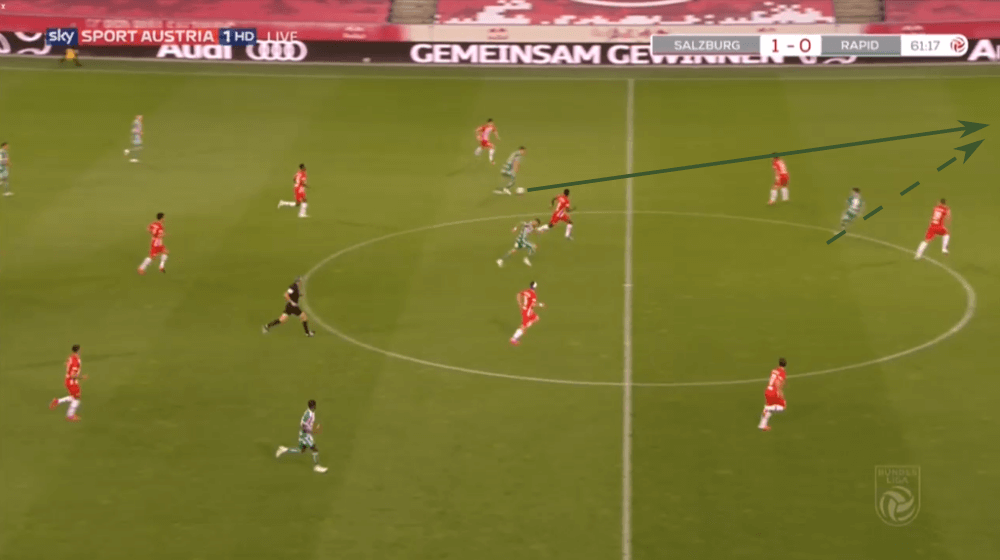
Marsch’s adjustment in the 36th minute
Since Rapid Vienna were quite strong in this match, Marsch decided after about 36 minutes to switch to another system. The main problem was that Arase and Ullmann often had quite a lot of time when they received the ball due to the numerical advantage (5vs4) of Rapid in the highest line.
The solution of the American coach was to add Mwepu to the defensive line to create a back five. From there on Junuzović, Ashimeru and Szoboszlai were the three men in front of the back five while Hwang and Daka remained the two strikers. In the graphic below we can see the adjustment. The switch to a back five meant that Ulmer and Vallci could position wider without giving away to much space in the centre.
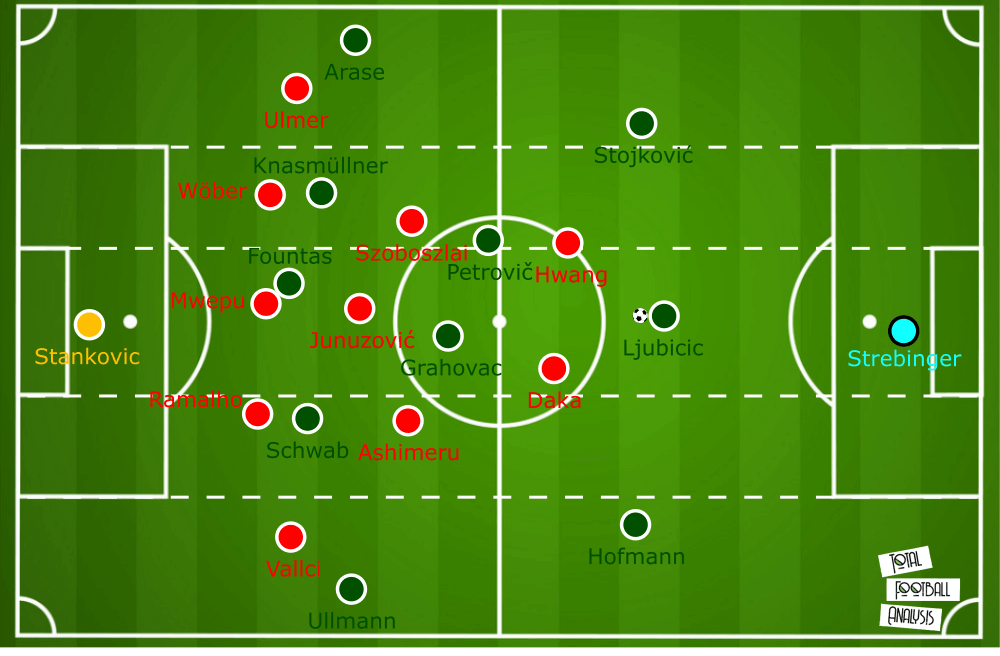
This meant that Rapid didn’t have such a clear numerical disadvantage in the centre and in the moments when Schwab and Knasmüllner dropped, they even had more bodies in the centre. The switch to the new system gave Rapid more space in the centre and from there on they didn’t focus that much on the wide-areas and also tried to progress the ball through the middle of the pitch. Due to that, they had more options to progress the ball further up the pitch.
In the shot below we can see a situation just moments after the adjustment. Ashimeru and Szoboszlai are seemingly not yet completely aware of their new position, Junuzović gets dragged to the left half-space and the centre is vacated. However, Rapid aren’t able to make the most of it.
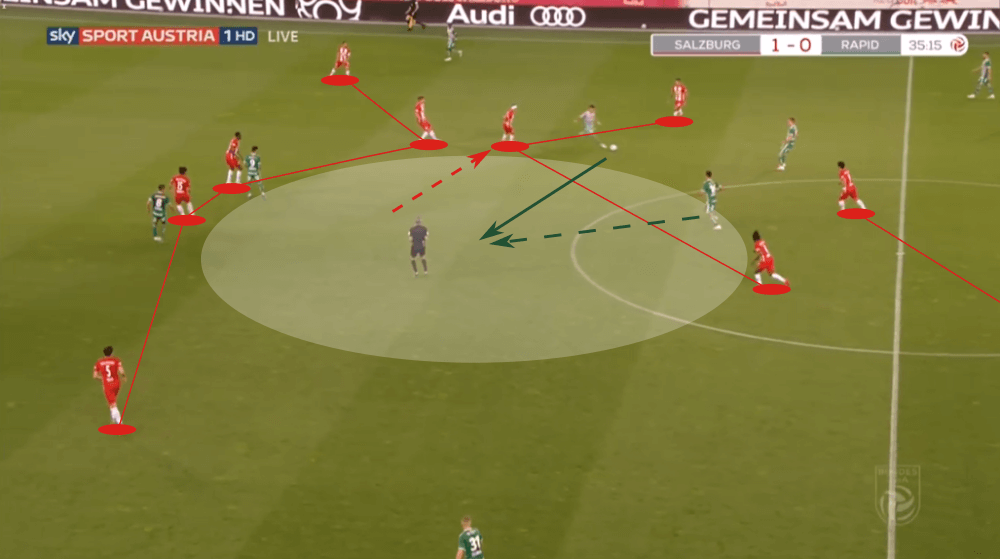
Despite the switch of Salzburg, Kühbauer’s side had more space in the centre and due to that had more options to get forward. Salzburg had more bodies in the last line and Rapid Vienna couldn’t make that much use of Ullmann and Arase anymore since the wide-defenders of Salzburg could move out earlier. Throughout the rest of the game, neither team was able to get control of the fixture for a long period and it was an evenly-matched game. The fact that Rapid had to finish the game with 10 men shows how unlucky they were on this day with injuries and it is questionable how that game would have ended if nobody got injured.
Conclusion
Both goals in this game resulted out of long through passes behind the last line of Rapid as Salzburg made the most out of the pace of their strikers. Kühbauer’s plan to mainly play to the wide-areas and get from there behind the last line of the defence was quite interesting, but Marsch’s switch to a back five made Salzburg immune against it as Vallci and Ulmer were able to position wider and be positioned near Ullmann and Arase.
Since LASK lost their first game after the restart against Hartberg, Wolfsberger AC are now in the second position behind RB Salzburg (27 points) with 22 points. This win wasn’t a result out of an outstanding performance of Salzburg, but it was an important win and a huge step towards the title.
Tired of commentary which tells you nothing new about the action in front of you? Well, we’ve got a solution. We’ve partnered with HotMic to provide live commentary and analysis of the best football action from around the world, and we’re covering some of the best matches in the Bundesliga this weekend! Download the HotMic app and sign up using the code ‘TFA2020’ to keep up-to-date with all our coverage – we’ll be covering the Premier League, La Liga and Serie A as well when they resume, so make sure to follow us on the app, and get in-depth analysis and tactical knowledge from the best analysts in the business!
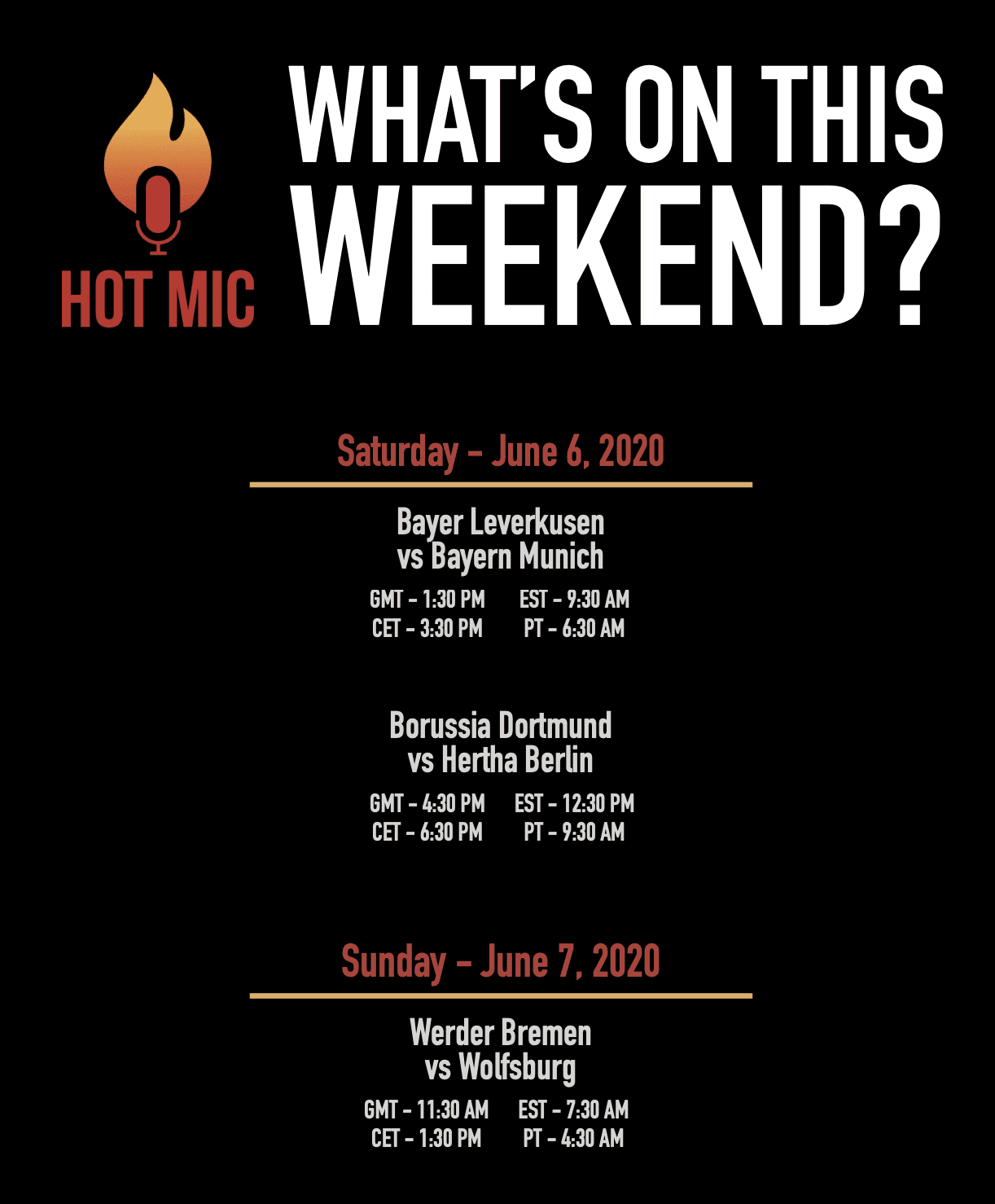




Comments